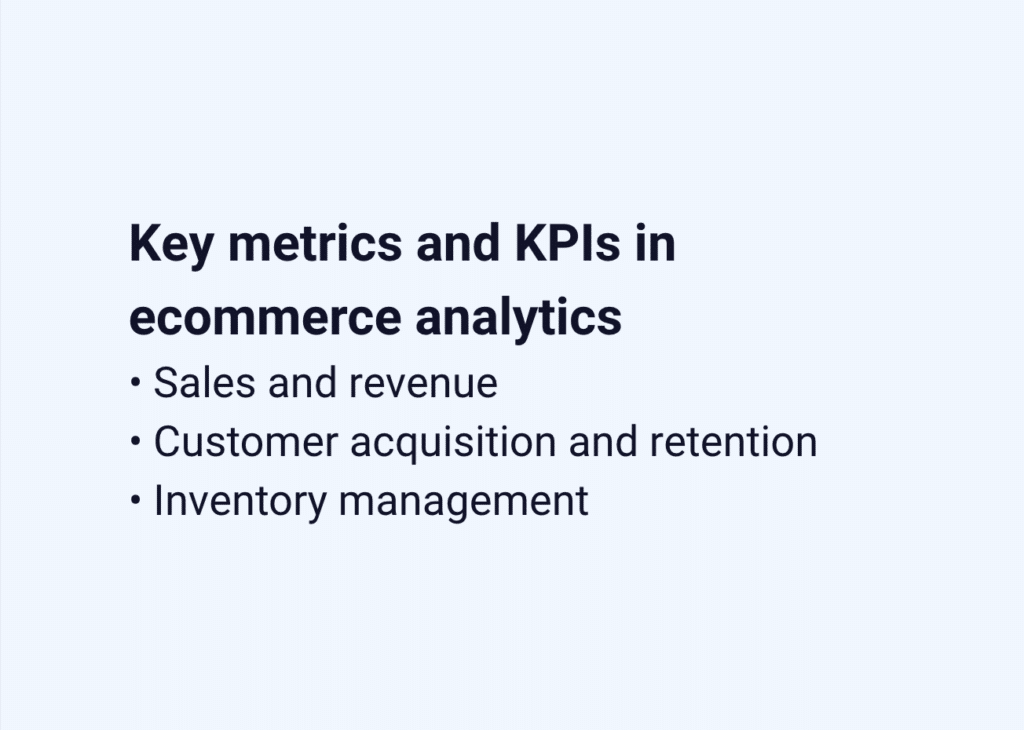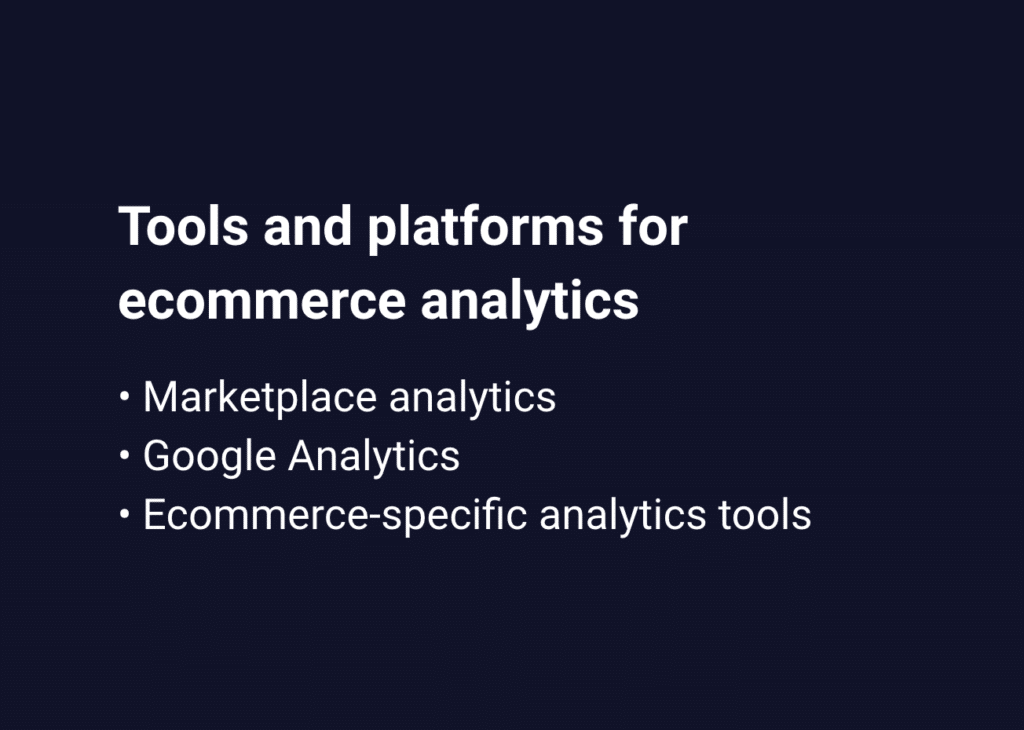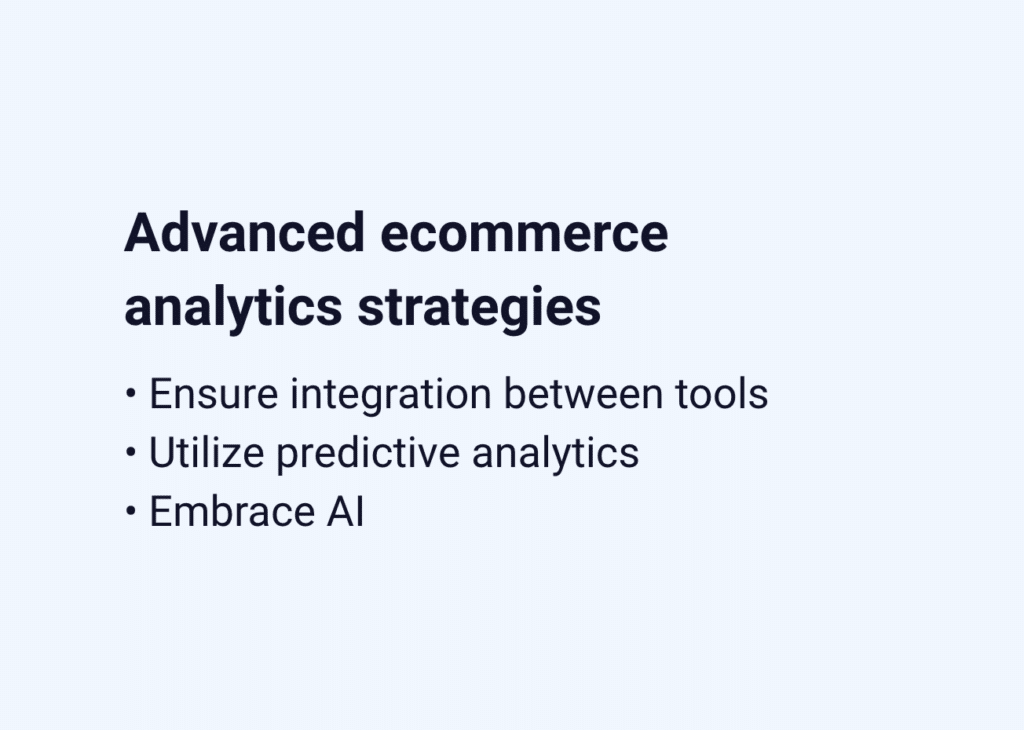Ecommerce analytics: How you can use data to help you scale
So, your online business is up and running, now what?
It might be time to look at scaling up, and that’s where ecommerce analytics comes into play.
Understanding the intricacies of your business’s data isn’t just a nice to have. Ecommerce analytics is the lens that brings the bigger picture into sharp focus, transforming rows of raw data into a clear roadmap for growth.
We’re going to explore how this powerful tool can be your ally in making savvy business decisions. It goes far beyond simply tracking sales; it’s the key to unlocking the stories behind the numbers. We’ll reveal how every metric, from website traffic to customer retention rates, plays a crucial role in sculpting your business’s future.
Learn how to turn data into actionable insights that propel your business forward, and uncover how ecommerce analytics can catalyze your business’s growth and success.
What are ecommerce analytics?
Ecommerce analytics are the tools that give you a bird’s-eye view of your online business.
They collect, process, and analyze data from every corner of your digital storefront, from page views and clicks to sales and customer feedback. It’s the art of extracting meaningful insights from a sea of information.
In the competitive online marketplace, intuition only takes you so far. Ecommerce analytics offer concrete evidence about what’s working and what’s not in your business. They help you understand your customers’ behavior, preferences, and buying patterns. It’s like conversing with your market, where the data does the talking.
With these analytics, you can identify trends, foresee potential pitfalls, and spot opportunities for growth. They allow you to measure the effectiveness of your marketing campaigns, streamline your inventory management, and enhance the overall customer experience.
In a nutshell, ecommerce analytics provide the clarity and direction needed to make informed decisions. It ensures your business not only survives but thrives in the digital realm.
By leveraging these insights, you position your business to respond dynamically to changing market conditions and customer needs. You can stay ahead of the curve, continually optimizing your strategies for maximum impact.
The importance of ecommerce analytics
So, what does ecommerce analytics offer your business?
Data visualization and reporting
The power of ecommerce analytics truly shines when we talk about data visualization and reporting.
Visualizing data is like translating a foreign language into one that’s universally understood. Charts, graphs, and heat maps turn complex data sets into digestible, actionable insights, so you can see the story your data tells at a glance.
Data visualization brings to life the trends and patterns that might otherwise be lost in rows of data. For instance, a spike in website traffic becomes more than just a number when you see it in a graph correlated with your latest marketing campaign. It helps you quickly assess the impact of your strategies and make adjustments on the fly.
Effective reporting is another critical aspect.
Curating vast data into meaningful reports that align with your business goals is a key step here. Customizable dashboards and regular reports keep you and your team focused on the KPIs that matter most, ensuring everyone is aligned and working towards the same objectives.
Data-driven decision-making
Did you know that 58% of businesses make decisions based on gut feelings?
Incorporating ecommerce analytics into your decision-making process empowers you to make choices based on hard evidence rather than gut feelings alone.
This data-driven approach minimizes risks and maximizes the potential for success. Whether it’s about optimizing your product portfolio, adjusting pricing strategies, or enhancing customer engagement tactics, every decision is backed by data.
Analytics help you identify what products are flying off the virtual shelves and which ones are just taking up digital space. They also shed light on customer acquisition costs and customer lifetime value, allowing you to allocate your marketing budget more efficiently.
By understanding customer behavior and preferences, you can tailor your offerings and communications, creating a more personalized shopping experience that drives loyalty and repeat business.
When it comes to ecommerce, staying ahead means staying informed.
Data-driven decision-making isn’t just a buzzword; it’s an operational mantra. You can continuously learn from your data, adapt strategies, and embrace a culture where every decision is an informed one.
Turn your ecommerce analytics into a compass that guides you through the ever-changing landscape of the online retail world.
Key metrics and KPIs in ecommerce analytics


Successfully navigating the world of ecommerce hinges on understanding the key metrics and KPIs that drive your business forward. And while these indicators track performance, they are also the pillars that guide your strategic decisions and fuel growth.
Sales and revenue metrics
At the heart of ecommerce analytics lies the pivotal sales and revenue metrics. Total sales, average order value, and revenue growth are the cornerstones of financial analysis in the digital marketplace.
Total sales offer a clear picture of your business’s market performance, showing you the raw success of your sales strategies over a specific period. Delving into average order value unveils customer spending behaviors, providing insights into their purchasing power and preferences.
This metric is crucial in tailoring your product offerings and pricing strategies.
Revenue growth is the compass that points toward your business’ future.
It reflects your venture’s scalability and market impact, measuring how well your products resonate with customers over time. Monitoring this growth helps in assessing the effectiveness of your marketing campaigns and product appeal.
Strategically analyzing these metrics enables you to finetune your approach, ensuring every move you make contributes to a robust and profitable growth trajectory.
Understanding these financial metrics goes beyond mere number crunching. It’s interpreting what they mean for your business and using that knowledge to make informed decisions that boost your revenue and secure your place in the competitive world of online selling.
Customer acquisition and retention metrics
Understanding your customers’ journey from discovery to long-term loyalty is pivotal.
This is where customer acquisition cost (CAC) and customer lifetime value (CLV) metrics become invaluable.
CAC sheds light on the investment required to attract each new customer, encompassing everything from marketing efforts to sales expenses. It’s a clear indicator of the efficiency of your acquisition strategies.
On the flip side, CLV represents the total value a customer brings to your business over their entire relationship with you. This metric offers a window into the long-term profitability of your customer relationships.
Improving customer retention starts with understanding these metrics and then crafting strategies that enhance the customer experience. This could involve personalizing communication, offering targeted promotions, or improving customer service.
By focusing on nurturing and maintaining these relationships, you not only increase CLV but also create a loyal customer base that fuels sustainable business growth.
Inventory management
Efficient inventory management is a cornerstone of ecommerce success, and metrics like inventory turnover and stockouts are critical in this process.
Inventory turnover measures how often you sell and replace stock over a certain period. A high turnover rate typically indicates strong sales, while a low rate might signal overstocking or declining demand.
Stockouts, on the other hand, occur when items are unavailable for purchase, often leading to missed sales opportunities and potential customer dissatisfaction. Keeping a keen eye on stockout frequency helps maintain the delicate balance between demand and supply.
Data-driven inventory management, utilizing these metrics, is key to minimizing costs and maximizing efficiency.
By analyzing turnover rates and stockout occurrences, you can optimize your inventory levels, ensuring you have enough stock to meet demand without tying up too much capital in excess inventory. This approach not only reduces storage and holding costs but also improves customer satisfaction by ensuring popular items are always in stock.
Tools and platforms for ecommerce analytics


Harnessing the right tools and platforms can transform data into your ecommerce strategy’s engine.
Marketplace analytics
For many online retailers, marketplaces like Amazon and eBay are the battlegrounds where they connect with customers. These platforms come equipped with their native analytics tools, offering a treasure trove of data insights.
Amazon’s Seller Central and eBay’s Seller Hub, for instance, provide sellers with detailed reports on sales, customer behavior, and product performance.
These native analytics tools are designed to help you understand how your products are performing in the marketplace. They offer insights into sales trends, peak purchasing times, and customer demographics. This information is invaluable for optimizing product listings, pricing strategies, and promotional activities.
By leveraging these insights, sellers can hone their approach for each marketplace, ensuring they meet customer demands and stay ahead of the competition within these vast ecommerce ecosystems.
Google Analytics
Using Google Analytics in the world of ecommerce is like having your very own skilled guide by your side, providing deep insights into every aspect of your online store’s journey. This isn’t just counting site visits, it’s unraveling the story behind each click and interaction.
This tool is vital as it unveils how customers navigate through your store. From the products that catch their eye to the point where they decide to buy (or not), Google Analytics captures each and every moment. This rich data helps you enhance user experience, refine marketing strategies, and ultimately, improve conversion rates.
The real power of Google Analytics lies in its ability to segment and dissect data. It allows you to tailor your approach to different customer groups based on behavior or demographics, giving you the clarity to make informed decisions.
For ecommerce businesses aiming to understand their audience better and grow their market, Google Analytics is an indispensable tool.
Ecommerce-specific analytics tools
Specialized analytics platforms are the secret ingredient for a deeper understanding of your store’s dynamics.
What makes them so special?
These tools are custom-built for ecommerce, offering a laser focus on metrics that matter most in the online retail world.
Platforms like Linnworks stand out by offering advanced insights that go beyond basic analytics. They delve into the heart of ecommerce operations, providing clarity on everything from customer purchasing patterns to inventory management efficiencies.
Linnworks, for instance, not only aggregates data across various channels but also integrates seamlessly with other tools and platforms, creating a cohesive analytics experience.
The real charm of these specialized tools lies in their ability to simplify complex data, turning it into actionable insights. With functionalities like real-time reporting and predictive analytics, they empower ecommerce businesses to anticipate market trends and customer needs, ensuring that your online store stays a step ahead in the competitive digital marketplace.
Advanced ecommerce analytics strategies


Diving into advanced analytics strategies can unlock the next level in your ecommerce game, where data may just become your most strategic asset.
Ensure integration between tools
Juggling multiple tools without integration is likely to spell disaster. If your tools aren’t talking to each other, you’ll get a broken picture of your ecommerce workings.
Effective integration of cross-platform analytics tools is not just beneficial; it’s essential for a complete and accurate understanding of your business landscape.
Linnworks stands out as a beacon in this domain, adeptly merging data from diverse channels and platforms. This seamless integration crafts a cohesive narrative from your sales figures, customer interactions, and market trends. It’s like having a central command center where every piece of data from different sources converges, offering you a complete view of your entire business.
With this holistic approach, you can easily identify patterns and correlations that might be invisible in isolated data sets.
Moreover, Linnworks’ integration capabilities ensure that your decision-making is based on a comprehensive data set. This synergy allows for a more strategic approach to business planning and customer engagement. You’re not just gathering data; you’re weaving it into a tapestry that tells the full story of your ecommerce journey, enabling informed, strategic, and impactful decisions that propel your business forward.
Utilize predictive analytics
Leveraging predictive analytics is like having a time machine, enabling you to peek into the future and plan accordingly. This advanced form of analytics uses historical data, statistical algorithms, and machine learning techniques to forecast future trends and customer behaviors.
Predictive analytics can be a game-changer. It enables you to anticipate customer needs, optimize inventory levels, and even predict future sales trends.
For example, by analyzing past purchase data and browsing behaviors, you can predict which products a customer is likely to buy next, leading to more effective, targeted marketing campaigns.
Predictive analytics also plays a crucial role in inventory management. It can forecast peak demand periods, helping you stock up on popular items before they sell out. By predicting these trends, you not only meet customer demand but also avoid overstocking, which can tie up capital and increase storage costs.
Embracing predictive analytics means you’re not just reacting to the market; you’re staying one step ahead, making data-driven decisions that propel your ecommerce business into a more profitable future.
Embrace AI
Embracing AI in ecommerce goes beyond traditional selling, it helps to create a customer experience that is both intuitive and highly personalized. AI-driven personalization has the power to transform how customers interact with your online store, making each experience unique to their preferences and needs.
As of the latter end of 2023, 84% of ecommerce businesses are either actively working AI solutions into their business or have it as a top priority.
AI algorithms excel in analyzing customer data, including browsing habits and purchase history. This analysis enables your online store to offer personalized product recommendations, tailored email marketing, and even customized discounts. Such targeted interactions not only enhance the shopping experience but also boost customer loyalty and engagement.
AI’s impact extends to customer support as well, with chatbots capable of providing instant assistance and personalized recommendations. By integrating AI into your ecommerce strategy, you’re not just selling products; you’re offering a shopping experience that feels personal, thoughtful, and in tune with what your customers truly want.
Transform insights into impact
Harnessing data is key to scaling your online business.
From understanding customer behavior to optimizing operations, the insights gained are invaluable. Remember, it’s not just about collecting data; it’s about turning it into strategic actions.
Discover firsthand how the Linnworks platform can integrate your analytics, giving you the comprehensive view needed to make data-driven decisions and drive your business forward. Book a demo today, turn your analytics into action, and scale your business to new heights.
